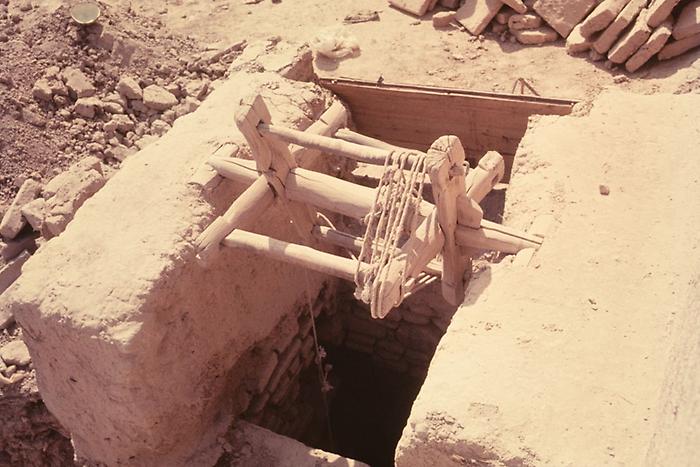Well Wheel / Schachtrad#

Photo ©Hasso Hohmann, 1973
The “Tschah i Tschoh”, the well wheel, is a wooden construction without any nail, which can be puzzled together and can also be taken apart for transportation. It is used to lift soil, sand or stones from the ground of a “Kanat“ through a vertical shaft.
A ”Kanat “ is an artificial under ground water canal which brings water from mountains under the desert to the large cities at cross points of main routes for caravans. These ”Kanats” can be more than a 100 km long and some are up to 4.000 years old.
The well wheel is use to lift material by stepping on the other side of the wheel on the horizontal beams. In this way it is use for the construction and repairs of these ”Kanats”.
From an airplane you see a series of round small mounds in a line, each surrounding a very small hole. These holes are the vertical entrances into such a “Kanat“.
Das “Tschah i Tschoh”, das Schachtrad, ist eine hölzerne Steckkonstruktion. Es wird bei Bau und Sanierung von “Kanaten“, unterirdischen, künstlich angelegten Wasserläufen unter der Erdoberfläche, eingesetzt. Kanate bringen kühles sauberes Wasser in die Oasenstädte mitten in der Wüste. Die ältesten Kanate gehen bis ins frühe 2.Jt. v.Chr. zurück. Sie können bis über hundert Kilometer lang sein. In gleichmässigen Abständen finden sich Schächte, die von kreisförmigen Aushubhügeln umgeben sind. Das Schachtrad dient dazu, Aushubmaterial in Säcken aus dem Schacht eines Kanates an die Oberfläche zu heben. Durch treten auf die vier Querhölzer auf der anderen Seite des Rades wird der Aushub heraufgehoben.